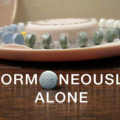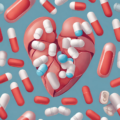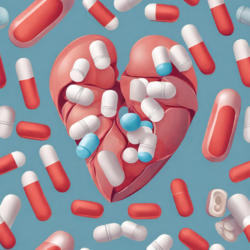What they say:
“Birth control is the safest, most tested drug on the market.”
What their tone says:
“Did you just crawl out from under a rock?”
I am not even sure the drug companies say this anymore. They don’t need to. It is buried into the psyche of a significant number of people who are willing to repeat it ad nauseam. Consequently, the masses hear it so frequently that they accept it as truth. It has become a part of our collective consciousness that few people question.
These implied messages that exist as a sort of “common sense truth” in our culture are not limited to birth control. Drugs occupy such status in our zeitgeist that you could probably quote a mantra implying the safety of nearly any of the most familiar drugs.
“Statins have been around for decades, and they’re the most prescribed drug in the world.”
“Accutane has to be safe. They wouldn’t give teens a dangerous drug for something as innocuous as acne.”
“Ritalin is a cute little pill they give kiddos to help them sit still.”
As Georg Cantor famously said, “A false conclusion once arrived at and widely accepted is not easily dislodged; and the less it is understood, the more tenaciously it is held.”
Beyond Statins and Birth Control
Pharmaceutical companies cultivate and manipulate these implied messages to their benefit. They know that we want their pills to work, and we want to believe any bad outcomes are rare. Consequently, we do not question the commonly accepted messages… until it is too late.
It would be an understatement to say Larry and his wife, Carly learned that the hard way. As Carly studied to become a nurse, she became more aware of the side effects associated with the steroids in hormonal birth control. She assumed she was safe because she had been taking them without issue since she was 18 years old.
However, when she turned 32, she discovered the limits of that carefree confidence. While undergoing a scan for something else, Carly learned that her liver had several large lesions, known as adenomas. The doctors told her they were a rare side effect caused by her hormonal birth control, and if left unattended, they could become cancerous. The doctors highly recommended surgery to remove the lesions.
The implied message behind the stated “rarity” of her condition was that Carly had simply lost the genetic lottery. She did not question how rare adenomas as a birth control side effect actually are.
Ultimately, she elected to have the expensive and very painful surgery to remove the large lesions. Then, she and Larry returned to life as normal. By itself, this event was not enough for them to seriously question Big Pharma’s implied messages – because said messages are “not easily dislodged.”
A Weakened State
A couple of years later, Larry started to notice he was losing strength in his arms and legs. At work, he found it harder to lift gear that had previously been no problem. As things progressed, he noticed that all his motor skills were getting “sloppy.” His feet felt floppy and kind of slapped as he walked.
He discussed it with Carly, and they agreed that it probably had something to do with his Ehlers-Danlos syndrome, an inherited disorder that had affected his joints for most of his life. They hoped that building in more time to rest and not overdoing it at work would help. However, over time, things progressed, and Larry feared it was something worse. Lately, he had trouble eating correctly and swallowing. Even breathing had become more of a task than any involuntary bodily function should be.
The couple began visiting specialist-after-specialist in an effort to untangle the mystery that was quickly growing more urgent. Multiple tests, scans, and even a $20,000 whole exome study of his DNA offered little more than educated guesses. The couple was told that Larry could have everything from ALS (Lou Gehrig’s disease) to limb-girdle muscular dystrophy, and with each pseudo-diagnosis, the implied message was that he had been issued a death sentence.
The specialists made little effort to hide that they were grasping for straws with each diagnosis; many seemed uninterested in the challenge of digging for a real, substantiated diagnosis. But, Larry and Carly found hope in one neurologist who seemed genuinely interested in finding answers for them. Her passion and dedication kept them going — right up until it became the vehicle that delivered them to their lowest point, when she told them that she was moving away because New Orleans had become too unsafe.
Out of the Darkness
Mentally, the couple felt like they were flailing out of control. With the exodus of their favorite doctor, the insurance company said their only option was a residency clinic. Larry was not excited about turning over his complicated case to a resident. How could he expect a medical student to find answers to an enigma that had stumped so many experienced physicians? But, if something is presented as your only option, you tend to roll with it, and that’s what Larry did.
The sympathetic young doctor-in-training listened intently as Larry laid out the narrative of his complex “patient history.” When he mentioned their attempts to land an appointment with the leading neurologist in the state of Louisiana, the resident said he might be able to facilitate a meeting (if not an appointment). That doctor’s office was right across the hall, and the resident thought he might be able to arrange something.
This was huge! The doctor’s schedule was packed, and there was no chance he would be taking new patients anytime in the near future.
Indeed, the good doctor agreed to meet with them after completing his rounds one evening. They sat on a hospital bed at the end of a long corridor waiting as the sun outside faded into evening. The anticipation made the wait seem longer, but it was worth it the moment he stepped into the room in his jeans and a polo shirt.
While this was not an appointment, the couple clung to a hope that his forensic analysis of their journey could lead to some pearls of wisdom. Maybe he could steer them in a new direction – anything that could help them feel like they weren’t just wandering through the desert alone.
For the next two hours, they shared every detail they could recall. The doctor interjected occasionally to ask questions. Most of his curiosities had already been explored. Disappointment was welling up in their souls. As the meeting began to wind down, it felt like this was going to be yet another pointless waste of time, but at least they did have the curiosity of a great mind that was now thinking about their case.
Then, as he was leaving the room, the doctor turned around and asked a question that changed the course of their lives forever, “Are you taking statins?”
Are You Taking Statins?
Even though Larry affirmed he was taking Lipitor and that the symptoms had commenced shortly after he started taking the drug, the doctor said it was a long-shot, but he asked them to run a test for anti-HMGC Reductase antibodies.
The test came back positive, and Larry was informed that he had a VERY rare disease known as statin-induced necrotizing autoimmune myositis. The implied message – he had really lost the genetic lottery. What are the chances that one couple could end up with two of these lottery tickets from hell?
We will get back to that. But first, this was not the end. It was the beginning of a different journey!
Sure, Larry had a diagnosis in hand, but he also had a LONG road ahead of him. The “implied messages” became much more overt.
What they said:
“We don’t see you going back to work…”
“You’re on disability, right?”
“You can get extra services if you will just apply for Medicare…”
What their tone said:
“This is your lot in life.”
“You will never be independent again.”
“Give up!”
Larry and Carly literally had to fight for his right to be self-sufficient. Carly spoke up when she thought his prednisone dose was too high. She used her medical knowledge as a nurse to be a strong advocate for her husband.
When one doctor expressed doubt that Larry would ever be able to regain his strength and essentially suggested they should give up, Carly exclaimed, “Get him back to 40%, and he will run the rest of the way!”
Striving for Normal
The trek back to (almost) normal has been and will continue to be arduous. Here’s what the treatment looks like that keeps Larry alive. Two days every month he goes into his doctor’s office to receive an IVIG (Intravenous Immunoglobulin) injection, which is a biological agent of pooled antibodies from thousands of people around the globe. Each injection takes six or seven hours and costs $64,000. That’s a little over $1.5 million per year.
On top of that, Larry takes 21 pills every day. That costs him about $500 per month out-of-pocket with his insurance plan.
So far, Larry’s insurance has covered the treatment, but he fears the day will come when they find a way to drop him. He has already had a taste of what life would be like without this treatment plan. The demise would be quick. His ability to walk and lift objects would go first, then his ability to speak. After that, he would need a feeding tube and then a respirator that would simply prolong the agony.
But, Larry does not dwell on what could be. He is too busy living his life and being grateful that things are (almost) back to normal. With that normalcy, Larry and Carly have begun to question some of the “common sense truths” and “implied messages” tied to the drug industry, “truths” that might actually be more like the “false conclusions” Georg Cantor spoke of.
Cholesterol as a Four-Letter Word
Most Americans grow up thinking of cholesterol as a bad word. More recent attempts to distinguish between good and bad cholesterol have done little to shift this perception. Before questioning some of the commonly held beliefs about statins, it is necessary to reframe our understanding of cholesterol.
First, your liver and intestines make cholesterol naturally, and let’s be clear – that is a good thing! You need cholesterol because it plays a key role in the production of vitamin D, bile, and hormones. It is also an essential building block of cell membranes throughout your body, and only about 20% of your cholesterol comes from the foods you eat.
Cholesterol is a waxy substance transported throughout the body by particles made up of proteins and fats, known as lipoproteins. There are two main classifications of these particles: high-density lipoproteins (HDL) and low-density lipoproteins (LDL), which you most likely know of as “bad cholesterol.”
The belief is that these low-density lipoproteins can form fatty deposits in your blood stream. If their levels get too high, they can interfere with blood flow and could eventually contribute to blood clots.
The Role of Statins
By 1976, the villainization of cholesterol had been in full-force for years, and researchers knew that the enzyme, HMGC reductase, controlled the rate of cholesterol production in the body. So, Japanese microbiologist, Akira Endo’s discovery of a biological agent that inhibited the production of this enzyme sent the drug industry into a frenzy.
From there, the developmental plan was pretty straightforward. They would create a drug that throttled the liver’s natural production of HMGC reductase. This would lead to less cholesterol, and theoretically less heart disease. And voila, you would have another new drug that could be handed out like candy.
Today, statins are the most prescribed drug class in the United States, with nearly 40 million people taking them every day. They also lead the way in the United Kingdom with nearly six million Brits taking them daily. However, continental Europe has taken a different approach, and the fallout has led to what has been labeled a Statins War.
While the US and UK have moved toward prescribing statins for anyone with a 5-10% risk of cardiovascular event, other European countries contend that the risks of side effects do not justify such a low threshold. For many of these countries, statins are only prescribed to try and prevent a second heart attack.
What Are the Risks?
Critics suggest that even the attempt to isolate “bad cholesterol” is based on a fallacy. They maintain that the body produces both forms of the lipoprotein for a reason, and that there has been no evidence proving a link between LDL and heart disease. However, statins have definitely been linked to some significant side effects, such as increased risk of Type 2 diabetes, memory loss, and muscle damage. In fact, one of the most common complaints associated with statins is muscle pain ranging from mild to demobilizing, but the industry has made a concerted effort to downplay this concern.
They claim your chances of experiencing any kind of muscle pain is only about 5%. Despite being such a low percentage, the drug companies allege that enough people have heard about muscle pain as a consequence that it has spawned what the industry describes as a kind of phantom, psychosomatic pain. In a play on the term “placebo effect,” they call it a “no-cebo” effect. In other words, the pain you think you feel is not real.
Their ironic, illogical attempt at drug-splaining has made its way into your local doctor’s office as well. When physicians were at a loss in diagnosing Larry’s ailment, they suggested he might be faking the symptoms – this is a common philosophy of modern Western medicine – “When in doubt, gaslight the patient.”
Muscle Damage
Scientists do not yet know exactly how statins damage muscles, or why it affects some people more than others.
Statins were designed, developed, and marketed with the entire focus on how it affects the production of a single enzyme within the liver. It accomplished what they wanted, but they ignored the unintended consequences.
Anytime you throw a natural process out-of-balance, secondary effects will occur. Recently, a team at the Max Delbruck Center (MDC) in Berlin conducted a study to see what effect the removal of this central enzyme might have on muscle tissue. They discovered that some 2,500 genes in the cells regulated differently, and this altered the production of more than 900 proteins. The head of MDC’s Myology Lab, Professor Simone Spuler concluded, “It is quite obvious that normal amounts of statins applied as active substances exert dramatic structural, functional and metabolic effects on the muscles.”
So, we may not know exactly how statins damage muscles, but we can see mountains of evidence that confirm something unsavory is happening. Perhaps doctors should stop acting surly when they don’t have answers and focus on finding those answers instead.
Inner Strength (and an Awesome Wife)
There are a lot of things that Larry wishes would have happened differently, beginning with that fateful day when his doctor first prescribed Lipitor. His cholesterol test came back a little high for the first time ever and because of his family history the doctor strongly recommended he start statins. Larry asked if he could try exercise and changes to his diet first, but the doctor insisted.
Larry tries not to dwell on the past or things he cannot change now. He accepts that his diagnosis is incredibly rare. However, he also knows that it is probably severely under-diagnosed. Very few doctors have the patience and wisdom to sleuth out this diagnosis.
Beyond that, he knows that muscle damage in general is not nearly as rare as the industry would have us believe. Some studies show that up to 20% of people who take statins develop myopathy.
Now that Larry belongs to the world of those who have been injured by statins, other people share their stories with him. He is blown away by the number of people who tell him they had to stop taking statins because the muscle-related side effects were affecting their quality of life. This is not a rare problem.
In the end, Larry no longer cares whether he lost the genetic lottery or any of the other implied messages they may want to throw at him. He knows a lot of women would have run away after hearing what his recovery process was going to be like, but Carly showed a resolve and determination that was almost superhuman – still working her nursing job through the day and then coming home to help him sort through his recovery. Her dedication and faith in him is what inspired him to take off running when they got him back to 40%.
Though necrotizing autoimmune myositis will always represent a persistent, unpleasant wrinkle in his life, Larry celebrates the accomplishment – knowing that he has not let it define him nor dictate how he lives his life.
Carly, too, considers herself fortunate that the damage inflicted on her body by hormonal birth control was not worse, for it surely could have been.
A New Resolve
Ultimately, the monstrous attacks on their bodies at the hands of dangerously overprescribed pharmaceuticals solidified their marriage. Each had the opportunity to demonstrate their commitment, not only to each other, but to the oath that joined them in sickness and in health. In the battle, individually and collectively, they developed an immunity to the implied messages of modern medicine and the tone in which they are delivered.
In their triumph, they have become health advocates for themselves and take nothing the doctors say at face value.
Perhaps Larry and Carly’s spirit of determination can inspire us all to cling to this new, and very real “common sense truth.” We should strive to be advocates for our own health and make sure we are fully informed before consenting to any treatment, especially when it involves a drug that is handed out like candy.
We Need Your Help
More people than ever are reading Hormones Matter, a testament to the need for independent voices in health and medicine. We are not funded and accept limited advertising. Unlike many health sites, we don’t force you to purchase a subscription. We believe health information should be open to all. If you read Hormones Matter, and like it, please help support it. Contribute now.
Yes, I would like to support Hormones Matter.
Image by Peter Timmerhues from Pixabay.













